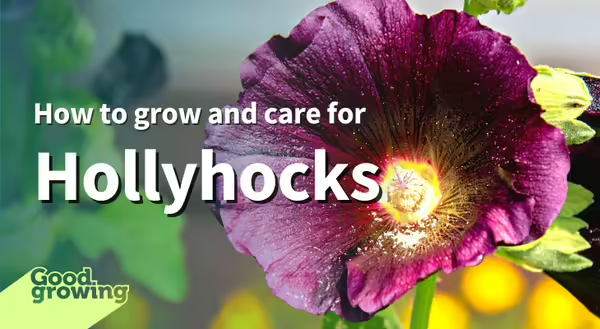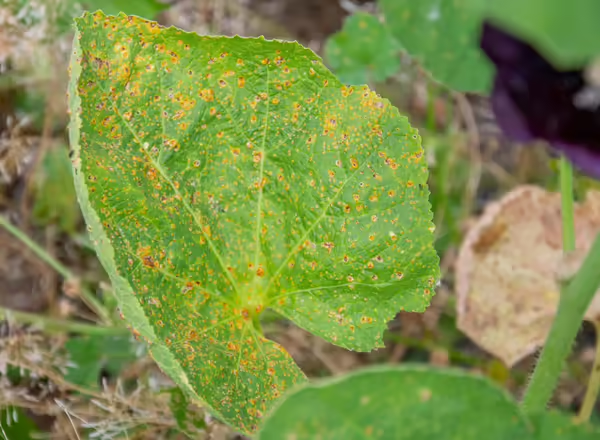
Hollyhocks (Alcea rosea) have been growing in gardens for centuries and remind many of us of our parents’ or grandparents’ gardens. Despite being ‘old-fashioned,’ hollyhocks have had a bit of a resurgence in recent years. Their tall, stately flowers are an impressive sight in the garden.
Growing hollyhocks
Hollyhocks are native to Asia and are part of the mallow family, along with cotton, okra, and hibiscus. Plants usually grow 3-6 feet tall, but some cultivars can approach 9 feet. Because of their height, they are commonly used as a background plant in a flower border or along a fence or wall.
Flowers will begin opening near the base and proceed up the stem. Individual flowers will remain open for 3 to 4 days, and plants will bloom for around four weeks from late spring to early summer. Red is the most common color for blooms, but they also come in pink, purple, yellow, white, and ‘black’ (usually dark purple).
Hollyhocks are biennials, growing as a rosette of leaves the first year and producing flowers the second. Occasionally, they are short-lived perennials. Despite being short-lived, they will readily self-seed, allowing them to persist in the garden (if plants are allowed to produce seed).
Hollyhocks are easy to grow. They grow best in a location with full sun and well-drained soil. Given their tall size and tendency to flop, they also benefit from having protection from the wind. If they are planted in a location that is exposed to wind, they may need staking to prevent damage. The main stems can also be pinched early in the season to produce bushier, shorter plants that are less likely to need staking.
Hollyhock pests
One of the most commonly encountered insect pests on hollyhocks is the hollyhock weevil (Rhopalapion longirostre). They are small, gray beetles with orange legs. Like all weevils, they have a long “snout” (which has the mouth at the end of it). The adults will feed on buds, tender stems, and emerging leaves. As the plants begin to produce flower buds, the adults will start feeding on them, and females will lay eggs in the buds.
The cream-colored larva will feed on the seeds and eventually turn into adults and emerge from the seed pod. This feeding can reduce the number of seeds produced, which can affect the ability of hollyhocks to maintain their population via self-seeding. Removing and destroying the infested seed pods can help manage weevil populations. Spraying plants with an appropriate pesticide can help manage beetle populations as well. Make sure to read and follow all label directions.
Hollyhocks are also a favorite plant of Japanese beetles. Adults will feed on leaves, causing the leaves to be skeletonized. Japanese beetles can be hand-picked from plants or sprayed with an insecticide.




Hollyhock rust
Hollyhocks are susceptible to a few diseases, the most common being hollyhock rust (Puccinia malvacearum). Infected plants will develop orange or yellow spots on the upper surface of leaves (usually starting on lower leaves). Eventually, brown to dark-red bumps will form on the undersides of the leaves. Minor infections won’t harm the plant. However, severe infections can cause leaves to shrivel and die.
Hollyhock rust can infect several different plants in the mallow family, including common mallow (Malva neglecta), a common weed that can serve as a source of the disease. Therefore, removing it if you have any in your landscape is important to prevent the spread of rust. If hollyhock plants are infected with rust, there are several things you can do:
- Once you notice rust on hollyhock leaves, remove the leaves to help reduce the spread of rust.
- When plants are done blooming, cut infected plants at the soil line and remove and dispose of the plant debris to prevent rust from overwintering.
- Mulch around hollyhocks in the spring to make it more difficult for rust spores in the soil to infect plants.
- Avoid planting hollyhocks densely. This will allow better air circulation that will help plants dry quickly and reduce humidity (which is needed for disease development).
- Avoid getting leaves wet when watering, and water plants early in the day so that if they do get wet, they dry quickly.
- Look for varieties that have some resistance to hollyhock rust.
- A preventative fungicide can be applied to plants BEFORE plants become infected or as soon as infection is detected (it will not get rid of the infection, only prevent it from spreading). Frequent treatments will be needed as new growth emerges.
Good Growing Fact of the Week: Hollyhocks are also called outhouse flowers. They were commonly planted around outhouses to hide them and so that people wouldn’t have to suffer the embarrassment of asking for directions.
Signup for our emails! Want to get notified when new Good Growing posts are available? SIGN ME UP
MEET THE AUTHOR
Ken Johnson is a Horticulture Educator with University of Illinois Extension, serving Calhoun, Cass, Greene, Morgan, and Scott counties since 2013. Ken provides horticulture programming with an emphasis on fruit and vegetable production, pest management, and beneficial insects. Through his programming, he aims to increase backyard food production and foster a greater appreciation of insects.